Published on September 11, 2012
By Thomas Van Hare
A SPECIAL EDITION IN HONOR OF THE MEMORY OF THE VICTIMS OF SEPTEMBER 11
Most know the intimate details of the terrorist attacks against the World Trade Center in New York City and the details of Flight 93 and its passengers’ heroism in averting yet one more tragedy. However, what happened on September 11, 2001, at the Pentagon, remains the least told and the least understood events of that day. What transpired when American Airlines Flight 77, a Boeing 757-223, was hijacked and purposefully crashed into the Pentagon that morning is a story of heroism, extraordinary luck and serendipity of the highest order. It is also a story of tragedy and grave loss. Nonetheless, from the smoke and ashes of that day, the Pentagon would be rebuilt and the nation would emerge stronger and more united — and it would fall to the US Military to ensure that justice would be delivered. This is the story of the Pentagon’s 9/11 — a dark day in American history.

The Attack on the Pentagon
As terrorist pilots aboard AA Flight 77 turned the plane to make a single orbit five miles south of Washington, DC, at low altitude, they picked out their target. The building was easy to spot — it was the largest and one of the most recognizable buildings in the area. Their target was the Pentagon.
Though it is impossible to know for sure, the terrorists may have been hoping to witness the arrival and attack of Flight 93, which was at that time already taken over by another team of terrorists. That other airplane was supposed to have flown into… what? Was it the Capitol? Was it the White House? Was it supposed to target the Pentagon also? Nobody will ever know, though most experts agree that the plot probably involved a crash of Flight 93 into the Capitol Dome, destroying the very symbol of America’s democracy and the seat of both houses of the legislature. The passengers aboard Flight 93 made sure that it didn’t happen, one of the most heroic stories of the day, though they would lose their lives in the process.
Flight 77 was a different story. After its single orbit, the terrorists on board likely realized that it was only a matter of time, perhaps minutes, before the USAF would arrive on scene and spoil their plan. In fact, air traffic controllers were already aware of the other hijackings and the events at the World Trade Center. They were watching Flight 77, thinking it might be a military plane given its speed and the overly reckless manner in which the pilot had descended and orbited tightly south of the city.
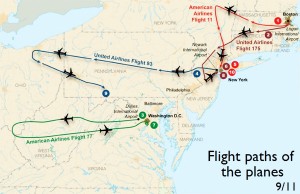
When Flight 77 came within a mile and a half of a nearby Air National Guard C-130 Hercules cargo plane that had just taken off from Andrews AFB, the pilot and aircraft commander, Lt. Col. Steven O’Brien, Minnesota ANG, identified the plane to air traffic controllers. His copilot, Maj. Robert Schumacher, and his flight engineer, Master Sgt. Jeffrey Rosenthal, also saw the aircraft. Rosenthal described the plane as either a Boeing 757 or 767 (he was quite correct) and from the paint scheme, he also recognized it to be likely an American Airlines plane (also correct). As he watched, the plane closed quickly until it literally filled his windscreen, then it made an aggressive turn directly in front of him, as he later recalled, and flew away, quickly exceeding two miles in distance on a diverging course.
Aboard Flight 77, the hijackers did not delay their attack much longer. The base of Andrews AFB was visible from the air from over the Pentagon, so close by, just to the east of where they had orbited. Langley AFB, with its well-equipped and expert pilots of the 1st Fighter Wing, then equipped with F-15 Eagles, is also near, located on the coast of Virginia a short distance to the southeast. The terrorists turned Flight 77 toward the Pentagon to make their attack. Their plan was simple — they would use the bulk of the fully fueled jet liner as if it was a suicide missile. The plane was packed with innocent passengers behind and the surviving flight crew members who were not killed during the hijacking. All destined to become victims of their terror attack.

Impact into the Pentagon
The terrorists turned the airliner one final time and approached from the southwest. They descended steadily toward their target, picking up speed as the altitude ticked down. The Pentagon was so large they could hardly miss. Their last view spread out in a vast panorama before them was of the city of Washington, DC, which filled the cockpit windows behind the Pentagon as they bored in. The Lincoln Memorial, Washington Monument, Jefferson Memorial, the Mall, the Potomac and Anacostia Rivers, the White House and Capitol Building were all clearly visible. It was a beautiful sight — and this may have been the reason that they elected to attack from that side, as they could looked toward the city, hoping to see the results of the attack of Flight 93. Seconds later, everyone on board, passengers, flight crew and terrorists, were dead from the impact.
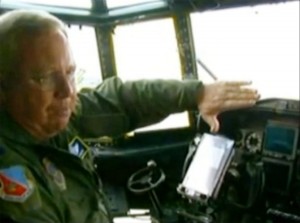
Still miles away, Lt. Col. Steven O’Brien, the aircraft commander aboard the C-130 reported a fireball on the ground. He was sure that the plane had crashed. He flew directly toward the rising column of black smoke. When close enough, he punched the radio transmit button and coolly reported to the air traffic controllers at Washington Reagan National Airport, “Looks like that aircraft crashed into the Pentagon, sir.” O’Brien would turn north and head toward his filed destination. He was heading back to Minnesota. In a weird circumstance, his course would also mean that he would fly close to the crash point of the last hijacked plane that day, Flight 93, where it crashed into a field in Pennsylvania. Weirdly, it would be his aircraft that ATC would ask to identify that plane and report on it as well — from 17 miles away from the point of impact, he would instead report the smoke cloud in the distance.
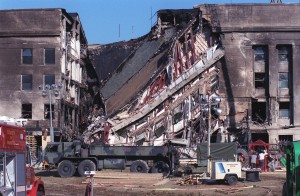
Hitting at the Wrong (or Right!) Point
What the hijackers didn’t know was that in approaching from the southwest, coincidentally, they were striking the newest section of the Pentagon. This “wedge” in Pentagon insider terms, had just been rebuilt during the Pentagon Renovation process, known as the “PENREN”. The Pentagon had originally been built in the early 1940s during World War II. To save on strategically important steel, it was poured completely without reinforcing bar supports within its concrete columns, walls and floors. Yet with the PENREN, the Secretary of Defense and the Pentagon’s Director, Administration & Management (DA&M), had agreed to pour new concrete walls, floors and pillars with modern steel rebar and concrete.
The one and only part of the Pentagon that the terrorists would hit was also coincidentally the only part that was newly reinforced and hardened. That single “wedge” was multiple times stronger than any other part of the historic building. Further, as the PENREN had just completed the reconstruction of that wedge in the weeks leading up to the attacks, the vast majority of that one corner of the Pentagon was yet to be occupied, another extraordinary bit of luck. While the Navy’s operations center and the Army’s personnel management offices had already moved in, much of the area hit by the aircraft was still vacant, a string of empty offices. Had the plane targeted any other section of the Pentagon, even 40 meters to the left, the casualty counts would have been multiple times over and the damage much greater.
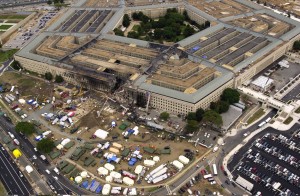
An Analysis of the Impact
As it happened, the terrorists misjudged their flight angle too. They were not professional, skilled, nor experienced. Most of their flight time had been in little trainer aircraft. They were unfamiliar with the scale and handling of the large Boeing jet that they were flying. Their pilot, Hani Hanjour, was a follower of the Dar Al-Hijrah mosque in Virginia under the then imam, Anwar Al-Awlaki. As with many of the terrorists, Hanjour was a Saudi Arabian national who had turned his back on the values of his country, religion and people. Plain and simple, he was a terrorist.
When Hanfour piloted the 757 down toward the Pentagon, he flew over the Sheraton Hotel on the hill overlooking the vast military office building. He barely cleared its roof before he pushed the nose down into a terminal descent. Overflying the adjacent highway, he managed to clip off five light posts with a wing. The plane’s descent angle was too steep and he misjudged the handling of the airliner. The plane was flying at 460 kts (530 mph). Thus, instead of hitting squarely into the base of the building, as he had planned, he plane came up short and struck the ground just a few dozen meters from the Pentagon’s outer wall of the E-Ring. The right wing hit a generator unit on the ground before the plane impacted. The impact point was not far from the military’s southwest Pentagon helipad.
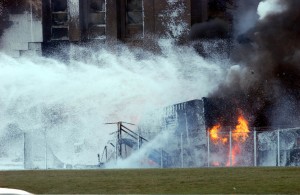
Losing a lot of energy from the early impact, the plane, already disintegrating, next hit the outer wall, striking not into the 1st floor but instead, while still on the 1st floor, some pieces of the plane were already heading upward at a low angle into the 2nd floor where the Army’s personnel office was located. Instantly, the bulk of the plane’s body struck the newly installed steel rebar of the strengthened walls and pillars of the E-Ring. Next the plane struck the ceiling, floor and interior walls, likewise all hardened and newly reinforced. Penetrating through the outer walls of each of the rings, the fuel tanks ignited as the plane broke completely apart. A fireball erupted within the D-Ring and C-Ring as the plane plowed inward toward, but it never reached the innermost ring — the A-Ring — beyond which was the open courtyard at the center of the Pentagon. At the center of that courtyard, a hotdog stand was preparing for the lunch rush, yet a few hours later. It survived the attack unscathed.
The End of the Attack and the What If?
By the time the plane hit the C-Ring, the momentum and energy of the pieces had faltered. That was as far as the main body of the plane would penetrate, though some pieces would make it into the B-Ring. The engines would come to a rest in the driveways that circle the interior of the Pentagon between each ring. Had the plane hit any other part of the building, it would have cut through the E-Ring, D-Ring, C-Ring, B-Ring, and even A-Ring then skidded across the courtyard, taken out the hotdog stand (known informally as the Ground Zero Cafe from its Cold War days as the central target of who knows how many Soviet ICBMs) and gone into the opposite side of the Pentagon. There it would have likely penetrated the A-Ring, B-Ring and probably even the C-Ring before finally coming to a halt. Though that statement involves some guesswork, it is not beyond reason to have expected that a better targeted hit on the older, non-reinforced Pentagon wedges would likely have taken down as much as a third of the entire Pentagon building.
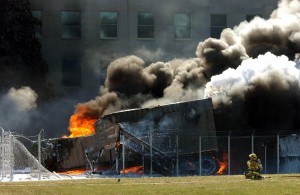
Had that happened, the casualties would have been immense — possibly on the order of 5,000 to 8,000 personnel, so tightly packed are the offices in the occupied sections of the building. But it was not to be. By the hand of God perhaps, the terrorists had chosen the one and only part of the building that was constructed with enough reinforcing rods and beams to stop the plane. Largely unoccupied, 246 were killed, of which 55 were uniformed service members. An additional 59 would perish on American Airlines Flight 77, plus the five hijackers. As it was, hearing the huge explosion, the employees working in the Ground Zero Cafe were unharmed. They stepped out to look around, wondering what had caused the noise they had so clearly heard. As they looked toward the southwest, they could see a grey-black could be seen rising from behind the inner rings of the building to the southwest. At that moment, they knew that something major had happened.
Then the evacuation began.
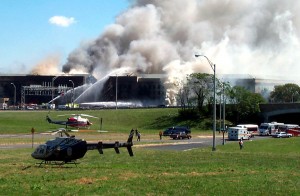
Evacuation and Aftermath
In hindsight, the Pentagon was ill-equipped to deal with a massive casualty event of the sort that happened on September 11, 2001. The building had few effective fire alarms, almost no emergency exit lighting, and no posted or practiced evacuation procedures. As smoke billowed through the hallways within the stricken wedge, many were overcome by the toxic cloud — there were no oxygen masks either. There was no central loudspeaker system to make a building-wide evacuation announcement. Instead, civilians and military personnel working in the building simply ran up and down the halls yelling for others to get out of the building. The reasons were not clear – just one wedge away there was no damage or significant smoke to be seen. Most sitting at their desks thought that they had just experienced a very mild earthquake. Their desks, chairs and bookcases had rumbled a bit, nothing more than that. People opened their doors into the corridors and asked one another, “What was that?”
As the evacuation began, word was passed by volunteers who raced through the corridors and yelled into each office to get out of the building. Many offices deal with classified information and are behind doors that are combination locked. The runners pounded from the outside, yelling as those within to put away their documents and evacuate. Nobody knew what else might be on the way. Had they been bombed? Had they been hit by a truck laden with explosives? Were there more attacks to come? The employees, civilian and uniformed, were unsure what to do. Evacuating, they simply streamed out into the adjacent parking lots — then looked skyward at the rising cloud of smoke. Word spread that an airplane had hit the building. Other rumors lit up the crowd.
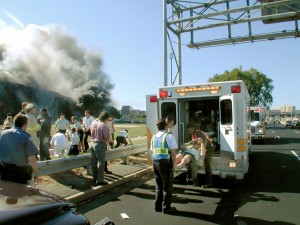
Outside the Building
Perhaps 15,000 to 20,000 men and women soon formed a large mass of people surrounding the building. They clustered together in groups in the building’s large, adjacent parking areas. Some walked to the nearby housing and shopping district called Pentagon City, though it was slow-going with crowds standing around and blocking the way. Some got into their cars and managed to drive away from the scene.
Most stood there and looked upward at the towering black cloud. They wondered what was coming next. They were military professionals and civilian experts who understood conflict and war, even if often from afar as they dealt with missions and programs on paper and computer. Now, suddenly it was personal.
Their training lead them to understand that the attacks would not be isolated. Most had moved to the opposite sides of the parking lots to get distance from the building, knowing that another attack would be dangerous to the crowds. Safety comes first with distance. As word spread of the news that other airplanes had hit in New York, the men and women looked skyward to see what else might hit them too. They knew what it was now — they were under attack.
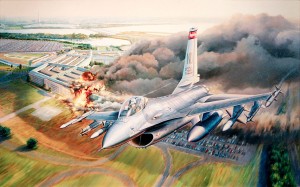
Minutes later, the first USAF aircraft arrived — an F-16 Fighting Falcon flown by Captain Dean Eckmann of the 119th Fighter Wing of the North Dakota Air National Guard. As he made a low pass over the building, he rolled the plane “to get eyes on the damage”. Immediately, he was on the radio giving the first aerial eyewitness report, a snap assessment of the damage that would pass up the chain of command all the way to the President of the United States, George W. Bush.
Unbeknownst to the pilot, down below, his arrival signaled something far more important — in the parking lot, a huge cheer rose up. Everyone knew that the cavalry had arrived and as one Pentagon officer later recalled, “nothing more will hit us today.” The F-16 and his wing man would orbit until they ran low on fuel. Other fighter planes would arrive and take over in a continuous patrol as nationwide, every civilian aircraft was ordered to land. The attacks had ended — and now, the next phase would begin.

Rebuilding
In the days after the attack, the Secretary of Defense, Donald Rumsfeld, gathered the Pentagon management team together. Secretary Rumsfeld was clear — telling the senior staff that the nation was at war. It was a singularly accurate statement. Indeed, America had just experienced the equivalent of another Pearl Harbor. Yet the second message was equally profound — we will rebuild.
And so they did. Within days of the attack, the plans were already underway to rebuild the Pentagon so that no damage would show. The terrorists and those who supported them would not have the pleasure of seeing a part America’s preeminent symbol of military power, the Pentagon, burned and gutted.
One year later, on the anniversary of the attack, the Pentagon would reopen the wedge where the terrorist attack had occurred. The PENREN team would do overtime, working around the clock, to pull off what many had thought impossible — they would rebuild the damaged section completely in record time. When completed, no outward evidence remained of the attack. The Pentagon, once again, was whole. America’s national security was in good hands. The reconstruction was perfect — the DA&M’s office would even find the same limestone quarry that had been used in the early 1940s for the original Pentagon blocks. Dormant in the Midwest, it was reopened to supply the replacement fascia.
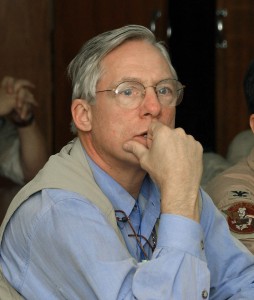
The DA&M, Ray DuBois, with his chief military assistance, Army Col. Brett Armstrong, would preside over the bulk of the continued rebuilding of the other wedges of the Pentagon. The work would be completed in June 2011. Among the innovations, in large part recommended by DuBois and Armstrong, would be the installation of a centrally-managed communications system for emergency use, as well as floor strip emergency lighting. Further, in line with Col. Armstrong’s background as a trained expert in nuclear, biological and chemical contamination, the Pentagon would be equipped with sealed emergency breathing hood apparatus units stationed at frequent and regular intervals throughout every hall of the building. As well, these would be issued kits to all Pentagon building employees to keep at their desks.
A Reminder
In memory of the event, a single large block of the burnt, blackened limestone was left in place on the outer wall at the point of impact. The block was engraved with a dedication to the events of that day. Behind it, a chapel was built on the first floor just beneath the impact point. Outside, a memorial park would be erected with benches that bore the names of all those who lost their lives that day.
The Pentagon, however, was busy with far more than its own rebuilding. Just months after the attacks, the first US soldiers would parachute into Afghanistan as the Global War on Terror began. Those responsible would be brought to justice.

Final Thoughts
In the end, it would take a lot more than a terrorist bloc half a world away to seriously America and the Pentagon. Though the war would take more than a decade, Al-Qaida, the sponsor of the attacks, would be devastated, its leadership decimated, its rank and file killed and its organization dismembered. Even its leader, Osama Bin-Laden, would die from the bullets of a US Navy SEAL in a daring surprise nighttime attack on his living compound.
The once extensive terrorist movement of Al-Qaida is today on the ropes, counting the months and years before it ceases to exist. New terrorist movements have arisen from the ashes of Al-Qaida, and the terrorists are still trying to fight what can only be a losing war. TThe West’s overwhelming military forces have been brought to bear and the outcome is not in doubt.
Some day in the near future, Al-Qaida will be just another name mentioned in school book histories. Their ill-fated, ill-conceived efforts at attacking the West, America and the values of freedom, liberty and democracy, and those other terrorist movements that will follow in their wake will not learn the key lesson of history — their vision of terrorism and violence cannot win.

The outcome of this war was never in doubt, even from the first minutes after the attack. It seems that those who would target freedom and hope in the future of mankind rarely understand one simple point — they had lost their war even before they began it. It would take the sacrifices, commitment and heroism of a new generation of America’s soldiers and airman (and indeed all Allied nations) to prove that point — but that is another story….
Buy the book: No Easy Day, by Mark Owen:

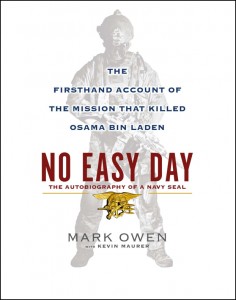
May God bless all the victims of 9/11.